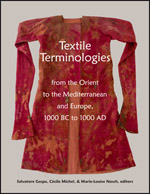Centre for Textile Research
Date of this Version
2017
Document Type
Article
Citation
In Textile Terminologies from the Orient to the Mediterranean and Europe, 1000 BC to 1000 AD, ed. Salvatore Gaspa, Cécile Michel, & Marie-Louise Nosch (Lincoln, NE: Zea Books, 2017), pp. 520-527.
doi:10.13014/K27P8WJ3
Abstract
One of the major challenges in costume and textile research is dealing with the vast number of terms related to textiles and garments, especially because similar terms are found in different languages and dialects, in various regions and over long periods of time, where they have survived in a complicated network of linguistic and cultural interrelations. There have been many attempts to collect textile terms in glossaries as parts of costume studies or as parts of museum archival projects. These glossaries however are usually limited to specific topics, geographical areas, languages, and time periods.
Creating a diachronic and global costume term base in the Greek language is of considerable value for textile terminology, since the earliest textile terms in the Greek language go back to the second millennium BC, retrieved from the clay tablet archives of the Mycenaean palaces. These early textile terms can be also traced in the vocabularies of other ancient languages, such as the word khiton (Greek: χιτών), which appears as ki-to in Linear B coming from the Semitic ktn.
An effort to systematize Greek textile terms in a databased system was initiated as a pilot program between the years 2000-2003 and it was first presented at the conference on Textile Terminologies from the Orient to the Mediterranean and Europe 1000 BC – AD 1000 and at the Euroscience Open Forum meeting (Copenhagen 2014). This study is now included in the present volume. The project took place during the recording of a costume collection, which was a joint project of the Peloponnesian Folklore Foundation, the Museum of Greek costumes and the Foundation of the Hellenic World. The term collection was initially focused on Greek traditional costumes of the 19th century. Soon after its first steps it became clear that the collection had to be extended to other periods, languages and areas adjacent to the modern Greek state in order to enlighten the etymology and the alterations of the terms. Moreover, through this linguistic pathway it is possible to trace a wide range of historical and cultural contacts between various ethnic communities within and outside these borders. Thus, costume terms from the oldest historical periods and from areas outside the current political and cultural boundaries of Greece have been included in this project.
The textile term collection, the structure of which is presented here, contains approximately 6000 terms directly related to clothing items but also to raw materials, treatments, implements and stages of manufacture, and also related to the physical conceptual environment of clothing production, e.g. fόrema (Greek: φόρεμα): dress and nyphikό (Greek: νυφικό): wedding dress, their use by specific social or professional groups, e.g. diadema (Greek: διάδημα): diadem, as well as special pragmatic and linguistic definitions linked to them, i.e. ghyaloméno (Greek: γυαλωμένο: textile finishing through applying glass pressure; from γυαλί: glass). At the same time, the collection includes terms concerning ancient garments, textiles and textile implements seen as archaeological finds, exhibition objects and as objects under conservation and research.
While compiling textile terms from various historical periods, we noticed that a high number of words derive from other languages, some of which reached Greek as loans or as results of mutual loans, while the origin of many other terms remains unclear. Alternative etymologies have been included with the main entries, and thus the dictionary, apart from being a place for collecting and explaining the meaning of the textile concepts, can also be used as an etymological tool for monitoring a perpetual traffic of textile related words in space and time.
Included in
Ancient History, Greek and Roman through Late Antiquity Commons, Art and Materials Conservation Commons, Classical Archaeology and Art History Commons, Classical Literature and Philology Commons, Fiber, Textile, and Weaving Arts Commons, Indo-European Linguistics and Philology Commons, Jewish Studies Commons, Museum Studies Commons, Near Eastern Languages and Societies Commons, Other History of Art, Architecture, and Archaeology Commons



Comments
Copyright © 2017 Salvatore Gaspa, Cécile Michel, & Marie-Louise Nosch. Photographs copyright as noted.